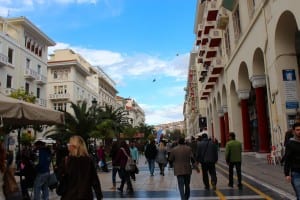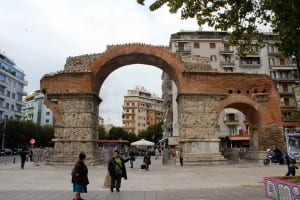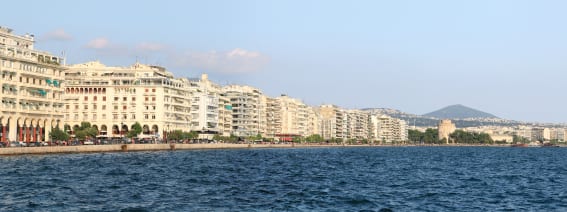“Just walk slowly,” he said. A rather odd answer to my inquiry about tips for sightseeing in Thessaloniki, Greece, but he was a local and the nods of agreement from his friends backed up the statement. In hindsight, his advice was the perfect embodiment of Thessaloniki: simple, yet significant; unhurried, but purposeful.

The βόλτα or stroll is embedded in the culture of Greece, and especially in Thessaloniki, which is the second largest city in the country and nestled beside the Thermaic Gulf of the Aegean Sea. Along the water, through the park or into Aristotelous Square, the Greeks enjoy their city on foot every day in a leisurely way that to an American eye brings to mind the term “Anti-New York.”
So we walked slowly, to the Byzantine walls of the city, under the Arch of Triumph of Galerius and past the ruins of his palace. We looked up at the mosaic ceilings inside the Rotunda, which began as a Roman temple of Zeus, but now houses a crucifix atop the alter.
We meandered through the food market, with stalls of produce, meat and flowers. Mounds of spices are also available—a reflection of the extra hundred years Thessaloniki spent under Ottoman rule, unlike southern Greece.
The city’s juxtaposition of the “old” and the “new” is a major contributor to the vibe of Thessaloniki and its position as “cultural capital” of Greece. People stop to buy chestnuts from the man on the corner next to the remains of Roman emperor Galerius’s 4th century palace, which consume blocks of downtown. They stroll down the seaside promenade to the 16th century White Tower, a Byzantine fortification-turned Ottoman prison-turned Greek museum, before hopping over to a trendy cafe, teeming with people nonchalantly drinking iced coffee and smoking cigarettes.

Though the crowds at the waterfront cafes may suggest otherwise, there is no shortage of options for where to sip your ouzo; Thessaloniki has more cafes and bars per-capita than any other city in Europe. And when it is time for lunch, the crowds settle in for a long meal, not with the sole purpose of fulfilling one’s appetite, but rather to enjoy the experience itself.
The city is renowned for its gourmet local specialties, and with its oceanside location, seafood is a prominent part of every menu. On recommendation from the concierge, we made our way to 7 Θάλασσες (7 Seas), where we sipped a local white wine and kicked off the meal with a salmon salad and sea bass tartare topped with roe. Stray cats stared, unblinking, waiting for us to throw some bits their way. The main courses came beautifully plated: cod drowning in jet-black squid ink and a seafood risotto heaping with scallops, mussels and shrimp.
We savored every meal there, watching the sidewalk fashion show go by while enjoying fresh bread served with fragrant olive oil, flakey white bream (European freshwater fish) drizzled with lemon, and sweet cake saturated with honey.

A thriving nightlife and major yearly festivals like the Thessaloniki International Film Festival keep the city at the forefront of trends.
The large youth population in Thessaloniki—mostly due to housing two of the country’s largest universities—plays a defining role in the nightlife, which Lonely Planet recently ranked as one of the world’s “ultimate party cities.” We walked past small taverns, huge nightclubs with English dance music, bars blaring rock music, jazz clubs and Bouzoukia (Greek nightclubs). Opting for a small cafe, we watched as “floating bars” departed from the White Tower for a trip around the gulf.
Before leaving Thessaloniki, we gradually made our way out to the suburbs to get a different perspective on the city. Taking smaller neighborhood streets, we laughed at the disorganization of cars double parked and on sidewalks, knowing very well that any Greek would counter, “That’s just how we do it here!” We sipped ouzo at a small restaurant on the beach and looked back at Thessalonik from the point, just making out the White Tower. The perfect goodbye to a city that is all at once bustling and peaceful.